Museums Doge's Palace | Guggenheim | Correr | Pesaro | Rezzonico | Murano | Accademia | Oriental | Ca d'Oro | Archeological | Querini | Bovolo | Pisani | Fortuny | Rocco | Lace | Marciana | Grassi | Dogana
San Rocco History Art | Location | Opening Hours Tickets | Authorizations
History Art Scuola | Rivalries | Crucifixion | Pilate Ecce Homo Calvary | Official Painter | Snake | Moses Manna | Sin Isaac Jacob | Adoration Temptation Breads | Probatic Pool Last Supper | Olive Garden Resurrection | Pianta | Annunciation Adoration Flight | Innocents Circumcision
The Scuola Grande di San Rocco in Venice Tintoretto's Sistine
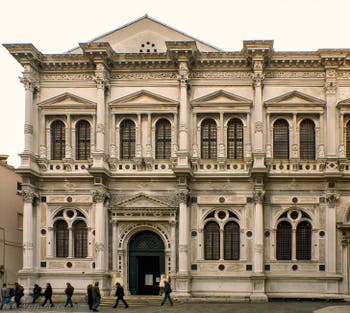
Scuola Grande San Rocco
Or “Tintoretto's Sistine”
With all its gilding, ceilings and walls decorated entirely with splendid paintings by Tintoretto, San Rocco is the most opulent of Venice's Scuole.Fortunately, its original decor has remained intact (as has the Scuola di San Giorgio), giving us a magnificent idea of what a Scuola Grande really was: a confraternity as prestigious as it was charitable.
. Charitable, because the Scuola di San Rocco (legally recognised in 1474) applied itself to helping the sick, and particularly the victims of the plague of 1576, following the example of Saint Roch, born in 1295 in Montpellier and miraculously cured of the plague, whose body was transported to Venice in 1485 and deposited in the Confraternity church in 1520.
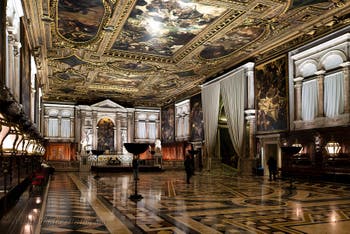
The upper room of the Scuola San Rocco San Rocco, was proclaimed Patron Saint of Venice after the plague of 1576 and his church thus became the site of an annual pilgrimage by the Doge and the Signoria.
The feast of 16 August is still celebrated solemnly in the square, in front of the Échurch and the Scuola di San Rocco, where a canopy known as “Tendon del Doge” is erected.
Prestigious, because all this wealth, all this interior splendour, was the culmination of a long and costly construction project, in rivalry with that of the Scuola della Misericordia
.
La Misericordia and San Rocco: a battle for prestige...
Four architects succeeded one another in bringing it to fruition: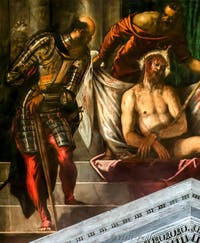
The Coronation of Thorns From 1516 to 1524 it was the author of the project, Bartolomeo Bon, who directed the construction work on the ground floor Renaissance style, until his departure due to a disagreement with the Confraternity over the shape of the staircase in 1524.
Sante Lombardo continued the work for two years and gave its definitive character to the facade overlooking the rio.
The challenge with the Scuola della Misericordia went far enough, so that in 1545 San Rocco had the grand two-flight staircase built by “il celesto” demolished.
It was replaced by an imperial-style staircase designed by Antonio Scarpargnino, who had taken over the work from 1526 to 1548, building the noble floor (the first floor where members of the Brotherhood met).
And while the Misericordia had to give up putting single columns on its façade for financial reasons, San Rocco added two series of single columns in the Corinthian style to decorate its own façade... completed, after Scarpagnino's death, by Gian Giacomo De' Grigi from 1549 to 1560.
47,000 ducats for 44 years of work
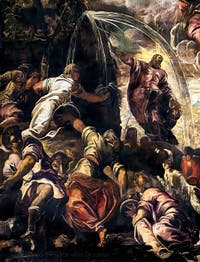
Moses gushing water The wealth of the Scuola di San Rocco continued to grow thanks to the many donors who relied on San Rocco to protect them from the many epidemics that were rife at the time.
It could therefore afford to call on the greatest painters to decorate the interior of the building, which took 44 years to build and cost 47,000 ducats.
The Grand Staircase by Antonio Scarpagnino
The walls alongside Scarpagnino's Grand Staircase will be decorated with works commissioned after the terrible plague epidemic of 1630, which claimed countless victims in Venice.To the left: The Intercession of St Roch, St Sebastian and St Mark for the plague epidemic to cease, and after the pillar, The Virgin saves Venice from the plague painted in 1673 by Pietro Negri.
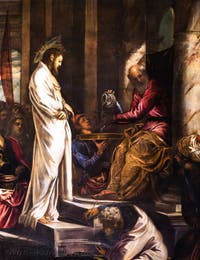
Christ before Pilate Right: The Virgin appears to the victims of the plague painted in 1666 by Antonio Zanchi.
Each of these works is made up of two canvases of impressive dimensions, 5.55m x 3.55m for the bottom section of the staircase and 7.05m x 6.35m for the top section.
These works, strongly influenced by the style of Tintoretto, commemorate this plague of 1630 after which the church of the Salute was built.
This staircase, worthy of a palace, leads to the rooms on the first floor, where the members of the Confraternity of San Rocco: the large Chapter Room, the small Chancellery Room, the entrance to which is immediately to the right of the altar in the Chapter Room, and finally the Albergo, at the far left.
History Art Scuola | Rivalries | Crucifixion | Pilate Ecce Homo Calvary | Official Painter | Snake | Moses Manna | Sin Isaac Jacob | Adoration Temptation Breads | Probatic Pool Last Supper | Olive Garden Resurrection | Pianta | Annunciation Adoration Flight | Innocents Circumcision
San Rocco History Art | Location | Opening Hours Tickets | Authorizations
Museums Doge's Palace | Guggenheim | Correr | Pesaro | Rezzonico | Murano | Accademia | Oriental | Ca d'Oro | Archeological | Querini | Bovolo | Pisani | Fortuny | Rocco | Lace | Marciana | Grassi | Dogana
Back to Top of Page

